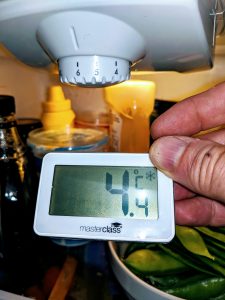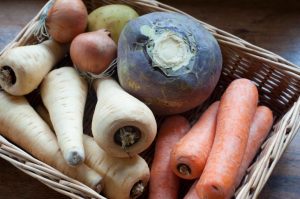If there was one thing I would urge you to try, if you are conscious about the amount of food you are binning and want a quick-win in terms of trying to reduce it, I would say: turn it down.
Your fridge, that is.
Wrap estimates that if fridge temperatures were lowered from, say, 7C to 4C, the storage lives of most chilled foods would typically increase by the equivalent of an additional three days.
The potential saving from lowering fridge temperatures and storing foods in there that are usually kept in ambient conditions, such as apples, could be £200 million and that includes the additional energy consumption involved in turning our fridges down (because they would have to work harder).
The research also found that the average UK domestic fridge runs at 6.6C. If we lowered our fridge temperatures to 4C (the recommendation is ‘below 5C’) the size of the food saving prize would be around 70,000 tonnes.
And if turning our fridges down resulted in an increase in CO2 emissions, the 13,000 tonnes of food waste savings required to break even would be more than covered by manufacturers being able to increase the life of their products by extending Use By and Best Before dates – but only if they were confident most of our fridges were operating at the right temperature.
Plus, those numbers do not include all the foods that might benefit from lower fridge temperatures. In our own experience, oranges last ages in there – see Nothing rhymes with orange – so do apples, yet only about a quarter of us keep them in there. We chuck away 63,000 tonnes of apples and 29,000 tonnes of oranges every year and that is the good stuff, not pips and pith.
So, how do you check the temperature of your fridge?
Well, unless you are lucky enough to have one with a digital (or other easy-to-read) display, you probably need to ignore that wobbly dial, located in the ‘ceiling’ of the fridge in our case and marked: -MIN- -1- -2- -3- -4- -5- -6- -MAX-.
The best way you can take the temperature of your fridge with any accuracy is with a thermometer.
Several months ago, The Other White House did exactly this. At first we actually used the thermometer whose previous employment had been taking the temperature of the small person’s bath water, but you can buy one at Wilko for the princely sum of two quid. We have since bought this one from Robert Dyas.
And what we found came as a real surprise/shock. Our fridge appeared to be at 8C.
It took turning the wobbly dial up to a Spinal Tap-esque MAX to get the temperature down to 4C and keeping it on -6- thereafter to keep it at less than 5C.

We noticed a couple of significant differences: 1) It feels a lot colder, which sounds a silly thing to say, but when you reduce your fridge temperature, you don’t half notice when you open the door and 2) fresh produce lasts a lot longer.
In fact, everything lasts a lot longer.
It is probably one of the simplest and most impactful actions a household can take to make the most of its food, because 41% (by weight) of the food and drink we bin is because we don’t use it in time.
Fresh vegetables and salads top the most wasted chart for this reason with 40% of fresh vegetable and salad purchases thrown away due to not being used in time, 34% of which ends up as wasted food (edible parts). That’s 1.3 million tonnes of edible fresh veg and salad and 300,000 tonnes of fresh fruit wasted every year …

